January 4, 2013
Air Date: January 4, 2013
FULL SHOW
SEGMENTS
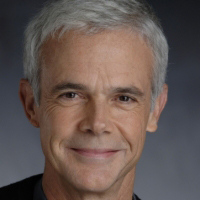
Remembering 2012 and Looking Forward to 2013
View the page for this story
Host Steve Curwood discusses the environmental highs and lows of 2012, and hopes for 2013 with Frank O’Donnell of Clean Air Watch, the Center for Biological Diversity'S Kieran Suckling, and Carl Safina from the Blue Ocean Institute. (02:00)
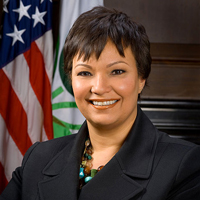
The Changing of the Environmental Guard
View the page for this story
Gene Karpinksi, President of the League of Conservation Voters, assesses Lisa Jackson as she prepares to leave her post as head of EPA, and Congress's more environmentally minded new members with host Steve Curwood. (06:40)
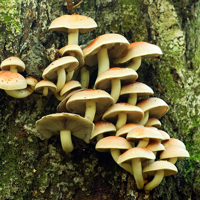
Fungi
/ Ari Daniel ShapiroView the page for this story
There's much more to fungi than the familiar mushrooms and toadstools. As Ari Daniel Shapiro reports, fungi are both the great creators and the great destroyers of the plant kingdom. (05:30)
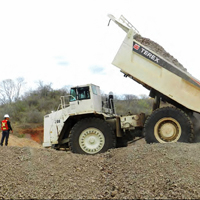
Gold Mining Boom
View the page for this story
As the price of gold continues to rise, mining smaller deposits can be very lucrative. Magazine On Earth writer George Black tells host Steve Curwood that in developing countries like Peru, rules are lax and environmentally destructive gold extraction is booming. (07:40)
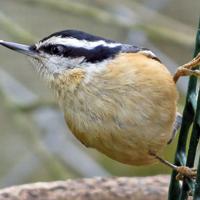
BirdNote ®- Winter Birds Love Suet
/ Mary McCannView the page for this story
In winter there are few bugs for hungry birds to eat so they flock to back yard suet feeders. BirdNote®'s Mary McCann reports. (01:50)
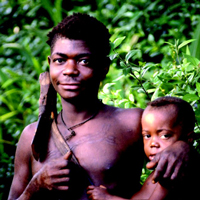
The World Until Yesterday
View the page for this story
Best-selling author Jared Diamond‘s new book “The World Until Yesterday” is part anthropology, part personal memoir drawing on decades of field work in New Guinea. He tells host Steve Curwood the book explores lessons westerners could learn from tribal cultures on issues as varied as conflict, childcare and personal safety. (14:00)
Show Credits and Funders
Show Transcript
HOST: Steve Curwood
GUESTS: Frank O'Donnell, Kieran Suckling, Carl Safina, Gene Karpinski, George Black, Jared Diamond
REPORTERS: Ari Daniel Shapiro, Mary McCann
[THEME]
CURWOOD: From Public Radio International - this is Living on Earth. I'm Steve Curwood. The make-up of Congress has changed with the new term - but it'll still be tough sledding for environmental priorities. A campaigner has some advice for the President:
KARPINSKI: It's not likely that the Congress is going to make progress when it comes to cutting carbon pollution, strengthening the Clean Air Act, and Clean Water Act, but the executive branch, using its existing authority, they can make incredible progress.
CURWOOD: How the President might forge ahead. Also, the secret life of fungi:
BODDY: Most of us think of fungi as things like mushrooms and toadstools. But that's just the tip of the iceberg. There's another part of the fungus - it's usually hidden in rotten wood and in the leaf litter on the forest floor.
CURWOOD: The fungus among us and its vital role in the ecosystem… we'll have that and more this week, on Living on Earth. Stick Around!
[THEME]
ANNOUNCER: Support for Living on Earth comes from Stonyfield Farm.
Remembering 2012 and Looking Forward to 2013
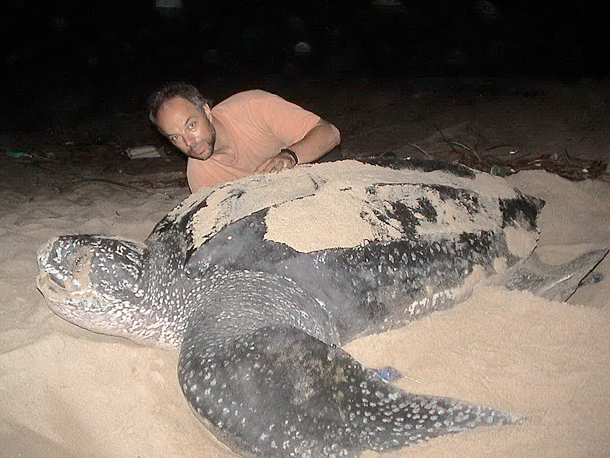
Carl Safina is the Founder of Blue Ocean Institute. (Blue Ocean Institute)
CURWOOD: From the Jennifer and Ted Stanley Studios in Boston, this is Living on Earth. I'm Steve Curwood. Before 2012 disappears completely in the rear view mirror, we thought we’d take a look back at some of the news of environmental change and where 2013 might take us.
Of course, topping the headlines last year were the killer storms and droughts, but not all the news was so dramatic and there were signs of other positive and negative trends that may mean more in the long run. Consider the air we breathe. Frank O'Donnell of Clean Air Watch follows it closely - and he joins us from Washington by Skype. Welcome to Living on Earth, Frank!
O’DONNELL: Hi Steve - great to start off the New Year being with you!
CURWOOD: Great that you’re here with us, Frank, and tell us, what happened in 2012 in the world of clean air?
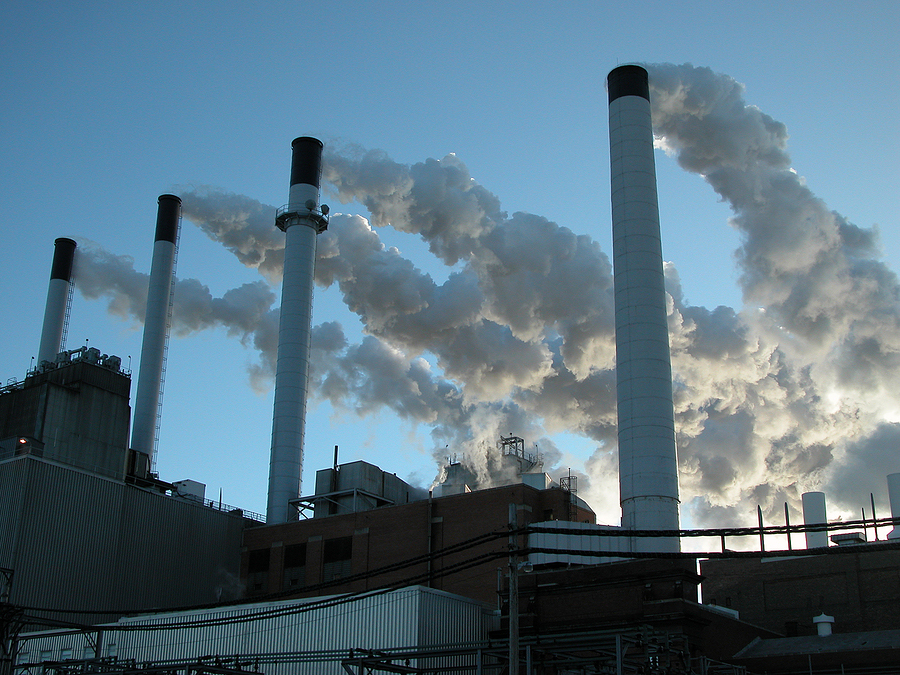
Pollution from a coal-fired power plan (photo: bigstockphoto.com)
O’DONNELL: Well, in the world of clean air, I think, we had some very significant accomplishments and one very unfortunate set back. On the positive side, during 2012, we saw the adoption of landmark standards to reduce mercury and toxic air pollutants from coal fired power plants. This is something that has been literally more than two decades in the works. These are terrific standards that will mean fewer emissions, fewer deaths, much less disease.
You will probably see some of the old dinosaurs go out of business and others will be cleaned up to new technology, and it’s a great new story from the standpoint of clean air. A couple of things that were very important in 2012: just recently the US EPA set new air quality standards for fine particle soot in the air.
This is another historic development because it’s the first time in 15 years that the EPA has tightened a critical standard that governs how much particle soot can be in the air averaged out on an annual basis. Particle soot is probably the most lethal of all widespread air pollutants. These new EPA standards will force continued progress over the course of the next 10-15 years and Americans from coast to coast will be breathing easier as a result.
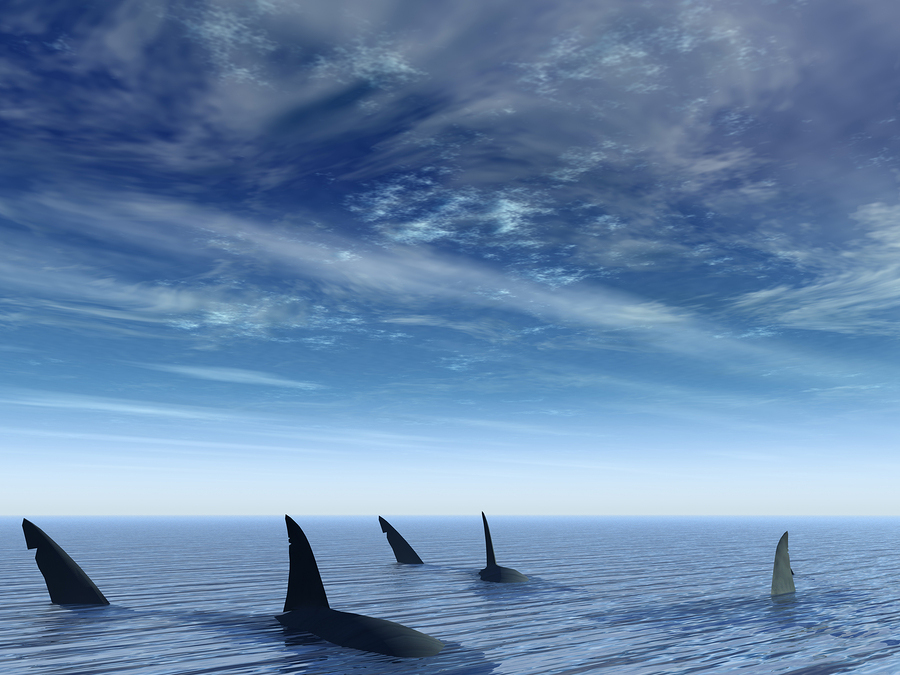
2012 brought an increase in the number of shark sanctuaries world wide. (Bigstockphoto.com)

(Bigstockphoto.com)

Automobile emissions (photo: bigstockphoto.com)
CURWOOD: OK. Those are the positives… what was not so great, in your view in the world of clean air?
O’DONNELL: Well, 2012 was the worst year for smog, literally, in at least the last 5 years. That’s something that could be attributed to several things, perhaps, including meteorological conditions; it may have been hotter in some places and rained less. But it nonetheless is an ominous sign and one that shows that we need to do more to reduce smog; we can’t always just rely on the rain and the weather to wash the smog away.
Related to that was an unfortunate decision by the White House to keep the US EPA from moving forward with lower sulfur gasoline standards that would help reduce smog levels nationwide. In fact, lower sulfur gasoline is the single most effective way to make further reductions in smog at this point. The EPA has developed a plan, a proposal to do this, I think there were cold feet higher up in the administration because of the election and jitters - charges that this could impact gas prices.
Now we are seeing some political support for this concept. 13 Senators recently wrote a letter to the President led by Senator Gillibrand of New York saying, ‘this is a very important standard that needs to get moving.’ And we are optimistic that we will see a proposal in the coming months, and we hope we’ll see a final standard in 2013.

Frank O’Donnell (photo: Frank O’Donnell)
CURWOOD: What are the clean air stories that you’ll be following this year in 2013?
O’DONNELL: Well, a couple of things. I think first and foremost on the front burner is this question of the EPA moving forward with standards for low sulfur gas. But another thing that is going to be very important and related to this is an update of the national air quality standards for ozone or smog.
The scientists have basically found that there is still a very significant need to set tighter and tougher standards for our ozone because of the harmful health effects, even at levels that are today considered lawful. Right now, the EPA is on a schedule to propose new air quality standards by the end of 2013.
I anticipate that there is going to be a lot of battling over that because I think the affected industry groups are going to try to delay that further, arguing that either it is going to cost too much, or that it’s not necessary or both.
CURWOOD: Frank O’Donnell is the President of Clean Air Watch in Washington – thanks for joining us!
O’DONNELL: Thank you so much for having me, great to talk with you!
CURWOOD: So, some slow steps forward and a few back in cleaning up the air. When it comes to wildlife and biological diversity, 2012 was rough. There were wholesale massacres of elephants for ivory in Africa. And the warming planet hit polar ecosystems especially hard; affecting all manner of creatures from caribou to krill. Kieran Suckling of the Center for Biological Diversity joins us now to talk about the trends in his field - welcome to the program!
SUCKLING: Hi!
CURWOOD: So what stands out for you in terms of wildlife conservation and biodiversity for 2012?
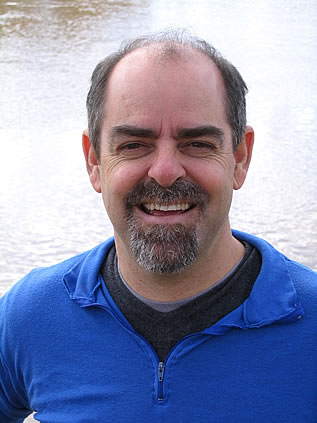
Kieran Suckling is director of the Center for Biological Diversity. (Center for Biological Diversity)
SUCKLING: Well, we had some big setbacks and also some big victories. I think that the biggest setback for wildlife was the removal of the grey wolf from the Endangered Species List in Wyoming, and the subsequent frenzy of shooting, which has now killed hundreds of wolves in Wyoming, Montana, and Idaho.
CURWOOD: What was the rationale for taking the wolf off of the Endangered Species List?
SUCKLING: You know, the argument was that these wolves were eating cows. And so the ranchers were very upset with this, they wanted the wolves off the list, they wanted to be able to kill the wolves so they wouldn’t eat the cattle. But that really doesn’t add up because the number of cattle killed by lightning dwarfs the total number killed by wolves. More cattle are killed by dogs and logging trucks than by wolves. So it’s more of a symbolic issue, it’s more of an old culture that viewed the killing and removal of dangerous animals as the founding of civilization.
CURWOOD: What’s the good news coming from 2012 in terms of wildlife conservation and biodiversity?
SUCKLING: One of the really most exciting things is that the federal government finally re-started its program to give new protections to endangered species by putting them onto the Endangered Species List. During the eight years of the Bush Administration, the government had essentially shut down the process of putting new species onto the Endangered Species List. The very, very few that did get on there were all ordered by the court. So when the Obama Administration came in we negotiated with them whereby they would advance approximately a thousand species toward the Endangered Species Acts protection.
CURWOOD: Before you go, talk to me about the polar bear. This is an iconic animal, it was listed on the Endangered Species Act in 2008 and the reason being climate disruption. Now, how does one save the polar bear without addressing climate change?
SUCKLING: Well, you can’t. The overwhelming cause of the polar bear’s looming extinction is climate change. The ice is melting. So what we have to do is start to reduce greenhouse gas emissions to save the polar bear, but unfortunately the Bush Administration and then after that, the Obama Administration put into place rules that say we will not reduce greenhouse gas emissions for the polar bear. We filed a lawsuit first against the Bush Administration and then against the Obama Administration, so in 2013, the Obama Administration will have the opportunity to reverse itself and to begin dealing with greenhouse gas emissions.
CURWOOD: Kieran Suckling is Executive Director and Founder of the Center for Biological Diversity, thanks so much, sir.
SUCKLING: Thanks for having me on, I appreciate it.
CURWOOD: One effect of the failure to control greenhouse gas emissions is increasing acidity in the oceans - but when it comes to the state of the seas, it's not all bad news. That's according to the Founder of the Blue Ocean Institute, Carl Safina.
SAFINA: The highlights were that we're seeing a lot of movement that I thought was improbable on creating large marine protected areas and creating shark sanctuaries in some very large areas around the world. Those to me were the positive highlights. On the negative side, I think the most intractable problem that we have is the ongoing acidification of the ocean.
CURWOOD: And I suppose you rank the second negative as overfishing?
SAFINA: Yes, overfishing to date has been the major agent of change in the ocean, it’s the thing that has made the ocean much different than it used to be. But acidification is actually changing the chemistry of the water itself and that will have some very, very far reaching implications that I think go beyond overfishing because with overfishing you can fix it by stopping overfishing, but you can’t fix acidification very easily. And even if we stopped all of the burning of fossil fuels this afternoon, you would still have a lag of decades of increasing acidification as the carbon dioxide in the atmosphere continues to dissolve into the ocean.
CURWOOD: And for 2013, what do you hope or expect this year will bring for the world’s oceans?
SAFINA: Well, one good thing in US waters is that we are continuing to very effectively use a law that as of 2012 makes it illegal to have ongoing overfishing in the waters of the United States. So what we’re seeing is that many of these fish populations that were in decline are no longer in decline. And some of them are rebuilding, and that is all very, very positive.
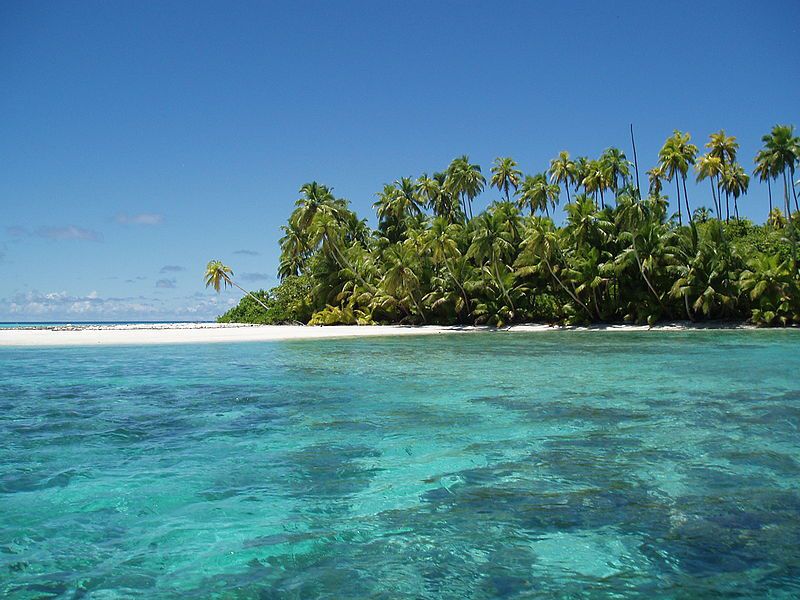
Marine protected areas, like the Cagos Archipelago pictured here, are a safe haven for marine species. (Wikimedia Commons)
I’m also looking at some data that suggests that the decades-long decline of Bluefin tuna in the ocean may be leveling out. That’s really, really good. And we’re looking at probably a continuation of a lot more of these protected area that are protected from fishing, or substantially protected from fishing, as well as more of these shark sanctuaries in different parts of the world.
CURWOOD: For the past four years in the United States, we’ve had at the helm of the federal marine policy, Jane Lubchenco, at the National Oceanic and Atmospheric Administration – she’s leaving office. What does that mean for the oceans going forward?
SAFINA: Well, it remains to be seen. Jane was a very, very strong advocate of science-based management. And people who don’t like science-based management did not like Jane. And of course, the only hope we have really is science-based management because if you don’t manage based on the information that you have, then you’re not going to make very good decisions. I certainly thank her for all of her service, but who is going to succeed her is an open question. There’s no really wonderful person that everybody would say that this would be the right person, so it will be an interesting process.
CURWOOD: Carl Safina is an author and Founding President of the Blue Ocean Institute, thanks so much, Carl!
SAFINA: Thank you so much for thinking of me.
Related links:
- Clean Air Watch
- Center for Biological Diversity
- Blue Ocean Institute
[MUSIC: Global Noize “Cosmic Hug” from A Prayer For The Planet (GNT Productions 2011).]
CURWOOD: President Obama is about to start his second term - with a reshaped environmental team - we look ahead. Stay tuned to Living on Earth!
[CUTAWAY MUSIC: Manu Katche: “Running After Years” from Manu Katche (ECM Records 2012).]
The Changing of the Environmental Guard
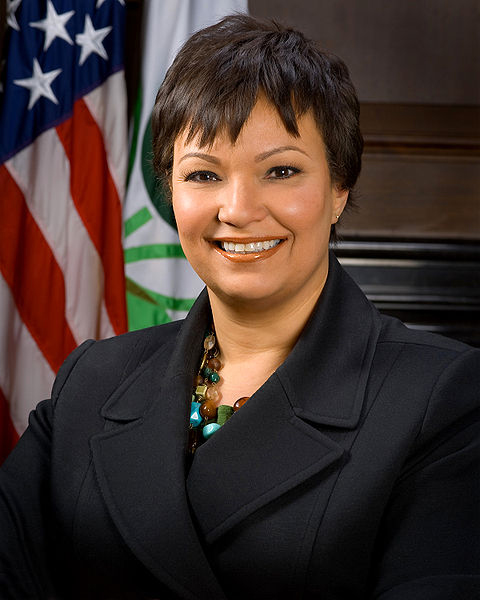
Lisa P. Jackson outgoing administrator of the EPA . (The White House)
CURWOOD: It’s Living on Earth, I'm Steve Curwood. With a new Congress in place, and President Obama about to begin his second term, we take a look now at the prospects for environmental policy through the eyes of the League of Conservation Voters.
The LCV scores legislators on the basis of their votes, and then vigorously campaigns for those it considers to be conservation-friendly, and against those it thinks are not, regardless of party. In the 2012 election cycle, it spent more than 14 million dollars and claims a success rate of 83 percent. LCV’s President is Gene Karpinski.
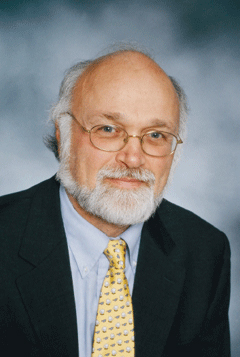
Gene Karpinski is President of the League of Conservation Voters. (League of Conservation Voters)
KARPINSKI: 2012 was an incredibly important election year, in fact, it was our most successful election cycle in the history of the more than 40 years of the League of Conservation Voters. And, that’s because we: number one, helped elect President Obama, who hasn’t done everything we wanted but has really been a champion on a lot of issues including making some progress on climate change.
We helped defeat the Flat Earth Five, five of the worst climate deniers in the House of Representatives. We went after five, but we beat four of them. And third, we put most of our energy into electing a whole new swath of new champions in the United States Senate.
We invested heavily in eight Senate races across the country and we won seven of those races… so people like Mark Heinrich of New Mexico, 95 percent lifetime score as a member of the House. Tammy Baldwin coming from Wisconsin had a 96 lifetime LCV score coming into the Senate from the House. Chris Murphy had a 98 percent lifetime score coming into the Senate in Connecticut from the House. So we have a lot of new people who have a track record, who have been leaders in the House of Representatives who are now coming into the Senate. Those are some examples.
CURWOOD: What about the House?
KARPINSKI: You know, the House is still a place that’s run by an incredibly anti-environmental leader in the sense of John Boehner. Frankly, the House that just concluded its work was from our estimation, based on our scorecard, the most anti-environmental House in history. So it will get a little bit better, but it’s still controlled by people who don’t believe that climate change is real and who want to roll back our critical Clean Air and Clean Water laws.
CURWOOD: Gene Karpinski, a lot of environmental activists backed President Obama for re-election, but now it seems that a lot of the strongest environmental advocates within his Administration are leaving. I’m thinking of Energy Secretary Steven Chu and of EPA Administrator Lisa Jackson. Why is that?
KARPINSKI: Well, you know, Lisa Jackson, she’s the only one that’s publicly announced that she’s leaving. And let’s be clear – Lisa Jackson has been an incredibly effective champion for protecting public health, and protecting our air and protecting our water. I think it was challenging for her because far too many times the most anti-environmental House of Representatives in history would call her up for these ridiculous hearings before the so-called House Science Committee and the House Energy Commerce Committee really questioning the validity of what the EPA does.
CURWOOD: What about her relations with her boss, though? President Obama pulled her back on the ozone rules that she wanted to move forward, and the word on the street is that President Obama won’t commit to blocking the XL Pipeline and that Lisa Jackson had to walk on that basis as a matter of conscious?
KARPINSKI: It’s clear that no EPA Administrator gets everything they want when they’re working for any Administration, quite frankly. But I think on balance, there’s no doubt that almost all of Lisa Jackson’s most important initiatives, administrative initiatives, went into effect.
For the first time ever, cutting mercury emissions from power plants by 40 percent. For the first time ever, taking aggressive steps forward to cut carbon pollution and other pollution in automobiles. It’s probably the single biggest step this government has ever taken to cut carbon dioxide pollution from automobiles, again, using the Clean Air Act in both those cases. She didn’t get everything she wanted, there’s no doubt about that, but she has in incredible track record and had made amazing progress.
CURWOOD: John Kerry is now expected to become Secretary of State after Susan Rice, whom Obama originally wanted, was criticized for reportedly owning stock in a company associated with the XL Pipeline for tar sands, how will John Kerry be as Secretary of State, how will he be on climate?
KARPINSKI: John Kerry has an incredible track record as Chairman of the Senate Foreign Relations Committee. There’s also no greater champion in the United States Senate on the issue of fighting climate change. He’s fought that issue for more than two decades, frankly. He’s a leader, he’s a visionary, he knows what needs to get done. It’s a difficult challenge internationally, to make progress on that issue, but no one knows these issues better than Senator Kerry and he has great relationships with foreign leaders across the world. And we’re looking forward to that new leadership.
CURWOOD: And what’s going to happen over at the Department of the Interior? Ken Salazar has been Secretary of Interior for the last four years, there’s been no announcement so far, why do you think that is?
KARPINSKI: At the moment there’s every indication that Salazar will be there for a while. I think he’s proud of a lot of the things that he’s done. He’s got a lot of important work to do. Take one example in Interior, in the last year in particular, they finally started to use what’s called the Antiquities Act – to use existing authority to create new monuments across the country, and there’s a lot more opportunities to do that in this second term without having the legislature.
You know, one of the most important lessons, I think of the next four years is, it’s not likely that the Congress is going to pass many if any laws to make progress when it comes to, you know, cutting carbon pollution and strengthening the Clean Air Act and the Clean Water Act, but the Executive Branch, using its existing authority or this Antiquities in Interior Department or the Clean Air and the Clean Water Act within EPA, they can make incredible progress. That’s what Bill Clinton did in his second term, and that’s what President Obama can do in his second term.
CURWOOD: How willing do you think he is to do that? I mean, for example, when he went to the New York area after Superstorm Sandy, the words ‘climate change’ didn’t pass the President’s lips…although of course they came out of the mouth of Michael Bloomberg.
KARPINSKI: Several times, Steve, since the election, as the President has articulated his top three priorities that he wants to get done in the next Congress, Climate Change has been one of those three. He mentioned in a recent interview, in his speech right after the Bill passed the House to address the fiscal cliff, so we’re confident that he understands the problem. Now, we need to make clear that ‘here are the particular solutions that are going to enable us to make progress.’
And those solutions are: elevating debate by using the bully pulpit, cutting carbon pollution of power plants, and rejecting the Keystone Pipeline. Those are the three specific things he should do to make the most progress on climate change that take no acts of Congress. These are things he can do using his own authority to make huge, significant progress.
CURWOOD: Gene Karpinski is President of the League of Conservation Voters, thank you so much, Gene.
KARPINSKI: Great to talk with you, Steve, keep up the great work.
Related link:
League of Conservation Voters
[MUSIC: Thievery Corporation “The Oscillator” from Sounds From The Thievery Hi-Fi (ESL Music 1997).]
Fungi
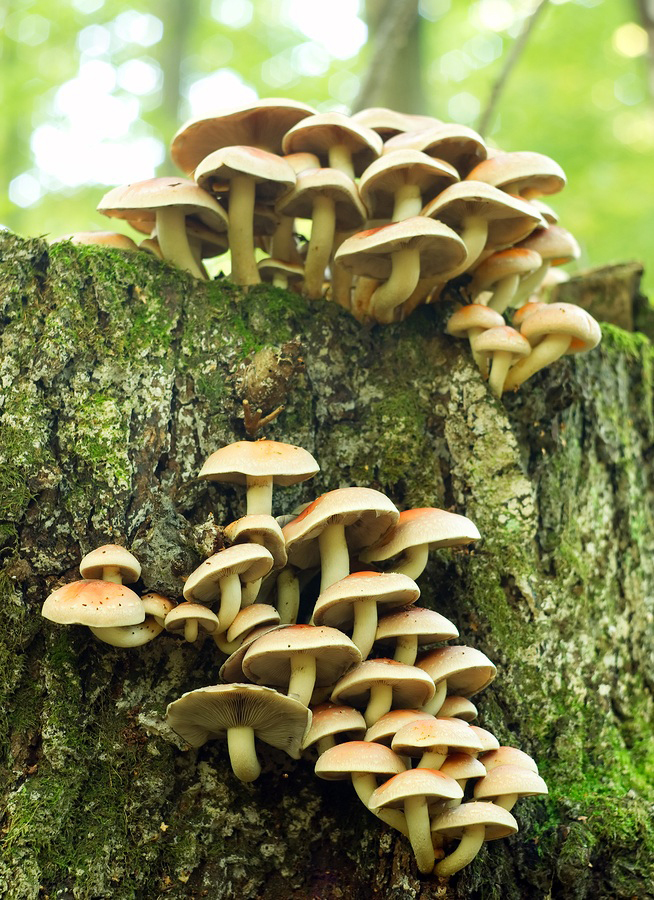
Sulphur Tuft fungus. (Bigstockphoto.com)
CURWOOD: Hamlet, that deep thinker, told his friend Horatio that there were more things in heaven and earth than were dreamed of in his philosophy. Well, Ari Daniel Shapiro has been bringing us regular insights into the myriad diverse species to be found in the living world. And today, he brings us a kingdom - and a riddle.
SHAPIRO: I’m pretty sure you haven’t heard this one before. What is all around us and very hard to see, and both dismantles and shapes our world?
BODDY: Let’s have a little look for another log.
SHAPIRO: Lynne Boddy – an ecologist from Cardiff University in Wales – is the one who gave me the idea for the riddle.
[RUSTLING SOUNDS]
SHAPIRO: She’s shuffling through the leaves in a little patch of forest in Concord, Massachusetts.
BODDY: Oh, look at this.
SHAPIRO: She’s spotted a soft birch tree log lying on the forest floor. Boddy kneels down and starts tugging on the log.
BODDY: We’ve turned over this log. Can you see this?
SHAPIRO: Oh, yeah! A few limp, cream‐colored threads descend from the rotting log and make their way into the soil. They look like plant roots to me. But I’m wrong.
BODDY: What we’re looking at is the main part of a fungus. Most of us think of fungi as things like mushrooms and toadstools. But that’s just the tip of the iceberg. That’s the fruit body, and the fruit bodies are like the flowers of flowering plants. There’s another part of the fungus – it’s usually hidden in rotten wood and in the leaf litter on the forest floor.
SHAPIRO: They’re really helping to kind of connect this rotting wood to the soil.
BODDY: That’s exactly right. They are.
SHAPIRO: These fungal threads – or mycelia – are doing the work of decomposition, slowly digesting and feeding upon this birch tree. One example is the sulphur tuft fungus.
BODDY: Hypholoma fasciculare.
SHAPIRO: An organism that grows both in the US and in Britain. Boddy gingerly holds its mycelium and begins tracing it through the soil.
BODDY: Oh my goodness! It’s attached to an acorn from this oak tree. So it’s not only decomposing the wood of the birch tree, but it’s decomposing this old acorn.
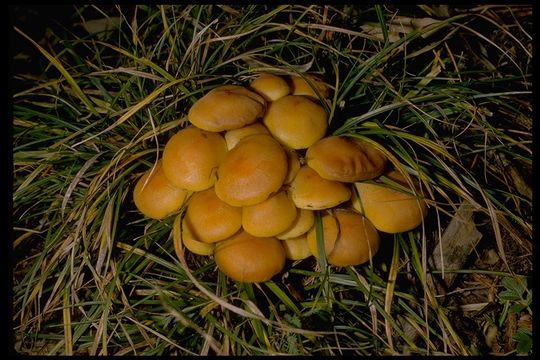
Sulphur Tuft fungus. (The Encyclopedia of Life)
SHAPIRO: A little farther along, the fungal threads have grabbed a hold of another little acorn hat, crawled along its perimeter, and surged out the other end in search of something else to colonize – a branch, a tree stump, or another log. Nutrients consumed in one part of the fungi get routed into this vast, interconnected mycelial network. And if one part of the network gets chewed up by a wood louse, say, or stomped through by a deer, it’s no big deal for the fungus. It’s so interconnected that there’s little risk of chopping one of these fungi in two.
Boddy loses the trail when the mycelia plunge straight down into the soil. But this fungal tapestry doesn’t just carpet the forest floor.
BODDY: In all of these trees that you see around us, there are fungi within the trunks and branches, not doing very much – just tiny, tiny, little pockets. And then the minute that the water in the sapwood of these trees stops flowing, these fungi will grow into bigger mycelia and start the decay process. So the minute this tree comes down, or even before, decay has started. Then spores will land, and they will try to get in, and it will have landed on a network of cords on the forest floor. And that fungus will get in too. And so we have a battle going on in this wood.

Sulphur Tuft fungus. (The Encyclopedia of Life)
SHAPIRO: A greedy battle over the nutrients locked up inside the newly dead tree. So that’s one portrait of the fungal community – lying in wait, wood‐thirsty, and skirmish‐ prone. But there’s another side to fungi. The benevolent side, and the second half of the riddle – what not only dismantles, but also shapes our world.
BODDY: None of these plants in this beautiful woodland would be here if it were not for fungi for two very good reasons. One is that the fungi, which are decomposing, actually release the nutrients that are locked up. Those nutrients can then be used by the trees around. And the second reason is that all of these plants, every single one of these plants around us have fungi attached to their roots.
SHAPIRO: These mycorrhizal fungi – species like Amanita brunnescens here in this woodland – associate with 90% of the plants on Earth. They ensheath the roots. Or sometimes they grow in between root cells. These fungi absorb water and nutrients from the soil, and share them with the plant. In exchange, the fungi get some of the sugars pulsing through the plant roots.
BODDY: It’s plants plus fungi that make the ecosystems of our planet work.
SHAPIRO: Plants are, I mean, I think of them as independent beings, you know, they just need the sun in order to survive, but you’re saying that they wouldn’t stand one minute without fungi.
BODDY: That’s absolutely true.
SHAPIRO: In fact, Boddy says that plants needed fungi to be able to colonize land 450 million years ago. So fungi both nourish and destroy. They pump vital fluids rich with nutrients into the very ecosystems that other fungi will later carve up and consume. They digest the dead, leaving behind the raw materials for new life to be born. And it just takes getting your hands a little dirty to trace the weave of their vast network.
BODDY: Ok, look here! Now, oh, that’s interesting, isn’t it?
[RUSTLING THROUGH LEAF LITTER]
SHAPIRO: For Living on Earth, I’m Ari Daniel Shapiro.
CURWOOD: Our story on fungi is part of the series, One Species at a Time, produced by Atlantic Public Media, with support from the Encyclopedia of Life.
Related link:
One Species at a Time
[MUSIC: Tony Monaco “Fungi Mama” from Burnin Grooves (Summit Records 2002).]
Gold Mining Boom
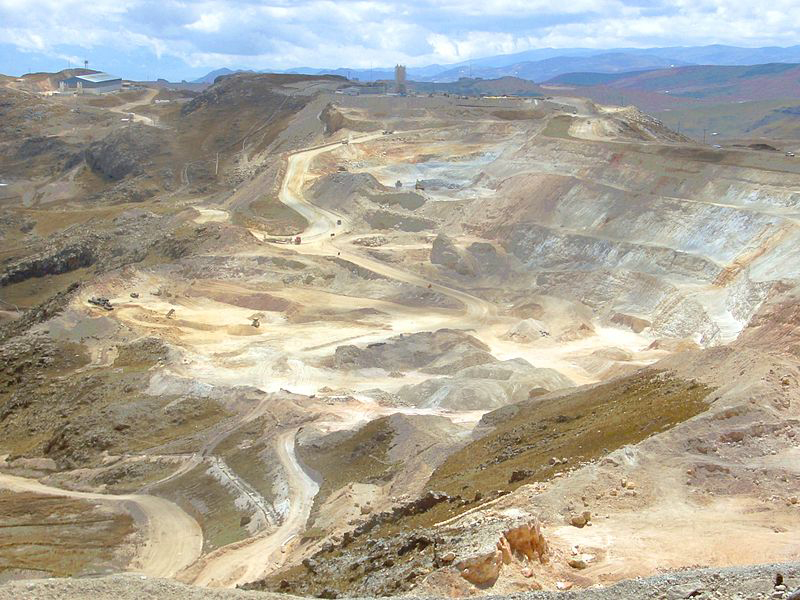
Yahacocha gold mine in Peru is the largest gold mine in South America. (Wikimedia Commons)
CURWOOD: The price of gold has increased dramatically in recent years - investors see it as a hedge and the growing middle class in Asia has a seemingly insatiable demand for the shiny yellow metal. So there’s a boom in gold mining, especially in the developing world, where, from the Congo to the Amazon, regulation of the toxic chemicals involved is weak.
George Black is executive editor of the magazine On Earth, published by the Natural Resources Defense Council. He recently wrote about the largest gold mine in South America in the Peruvian Andes and he joins me to talk about it - hello there George!
BLACK: Good day Steve, it's very nice of you to have me on your show.
CURWOOD: So, please describe for us this area of Peru, where the mine is and the natural environment there.
BLACK: This is at a very high altitude in northern Peru. It’s fairly arid, actually, it reminded me a lot of the Scottish Highlands, except 10,000 feet higher. So you’re talking about a mine that is between 12 and 14 thousand feet above sea level. And it covers, if you can believe this, 60 square miles that’s called Yanacocha, it produces more than a million ounces of gold a year, which makes it the biggest in South America and one of the biggest in the world. And the plan now is to open another mine called Conga right next to it, which would produce both gold and copper, which commonly occur together.
CURWOOD: So, in your article, in the magazine On Earth, you write that the days of a miner panning for gold on a river and coming up with a shiny nugget are over. They’re after much smaller amounts of gold, flecks of gold, in Peru. How do they get the gold from the Earth around it?

BLACK: That’s really the problem and it’s why these mines have grown so enormous. What you have now is literally fractions of an ounce of gold for every ton of rock. And what that means is that the rock is crushed into small, pebble-sized chunks. You pile those into mountains that can be hundreds and hundreds of feet high and then you snake pipes up the size filled with cyanide, sodium cyanide solution, and that drips down through the rock in a process that can take months. And cyanide has the property of being able to coalesce the fragments of gold into a sort of slurry that then collects in a pit at the bottom, and then that is processed and purified and then turned into gold ingots.

To use heap leach mining workers make huge piles of rubble extracted from the ground and spray it with cyanide to amalgamate gold. (Securities and Exchange Council)
CURWOOD: Huh. Cyanide doesn’t sound like the most healthy stuff.
BLACK: Well, cyanide is of course notorious because it has so many morbid associations for us. It’s what the Nazis used with Zyklon B. It’s a horrendous chemical when it escapes into the environment. So the first thing that you have to worry about with a large gold mine is the residue of this cyanide that is stored in huge tailings pits. If one of those tailing pits leaks or is flooded, for example, the results can be catastrophic. We saw one, which some people remember, about 10 years ago in Romania, where a tailings dam ruptured and hundreds of miles of the Danube were affected and all life in that stretch of the river was wiped out. So, yeah, a cyanide spill can be catastrophic.
CURWOOD: What environmental effects, if any, have resulted from this mining operation in Peru?
BLACK: Well, a number of effects. The most serious was in the year 2000, when a truck carrying 300 odd pounds of mercury, which is a byproduct of gold mining, spilled on the streets of a small peasant village. And people didn’t know what mercury was, so they ran into the streets, the kids scooped it up in their bare hands to play with it, families took it home in jars to put on their shelves and admire and show their neighbors and hundreds of people got sick.
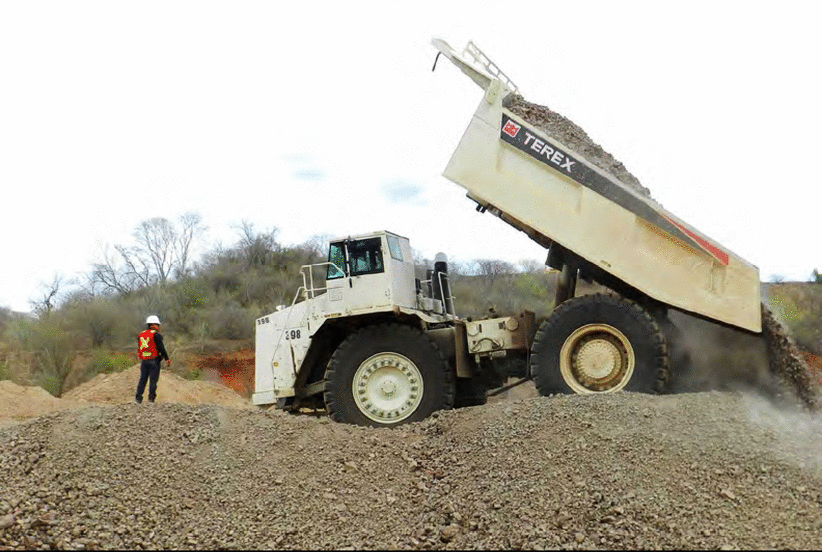
The second thing is a series of spills of heavy metals and arsenic into local streams, wiping out the fish life. There are also all sorts of public health issues that have never been systematically studied because a place like Peru doesn’t have the same kind of public heath epidemiological capacity that we do. So it’s a little bit like fracking here in a sense, that a lot of people get mysteriously sick; they have skin diseases. They have Pink eye, they have respiratory diseases, they have asthma problems and it hasn’t been conclusively proven, of course, that this is due to the mine. But what’s really significant is the buildup of these things just has bred 20 years of extreme mistrust, so people here are extremely nervous at the prospect of another mine opening.
CURWOOD: Tell me about the opposition to this mine. I understand that the people who live in this community are predominately indigenous, don’t want to see expansion there, and that the protests have gotten rather intense.
BLACK: Yes, they have become very intense. In fact, coincidentally when I was there this summer, the protest that had been simmering for about a year really erupted. We were detained and interrogated by mine security people. We were then, ironically enough, detained and interrogated by some local peasants who were basically threatening to assault anyone who was associated with the mine and we’d just come from there.
We got back to town that night, the town of Cajamarcha, and there had been riots all day…five people had been killed, we were tear-gassed. It was a very disturbed situation and a state of emergency was imposed. But this is increasingly typical. There had been three major incidents in Peru alone in the last year or two where people had been killed in violent demonstrations in three different parts of the country.
CURWOOD: What’s the livelihood of the people who live around this mine in Peru?
BLACK: The mining area around the town of Cajamarcha is basically a traditional peasant economy based on livestock, largely. It’s a famous dairy center, lots of local cheeses, dairy products, a certain amount of agriculture, things like pigeon peas and wheat. What people mainly depend on in agriculture, of course, is water, and the main threat that comes from a big mine is the colossal amount of water that it uses to dilute the cyanide that is needs to extract the gold. So there’s a constant threat on these people’s water supply, which is probably the single thing that makes them angriest.
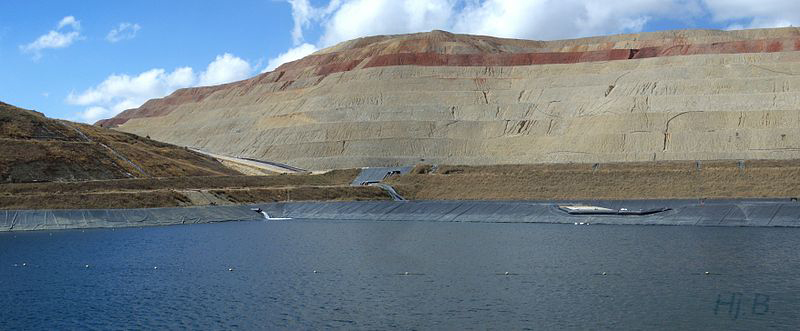
For Peruvians building a reservoir of water is not the same as a natural lake. (Wikimedia Commons)
CURWOOD: Is it the volume of water that they’re worried about, the poisoning of the water, or both?
BLACK: It’s both. And more than that I would say it’s the symbolic value of that water. You know, the company’s response will be: OK, we’re going to drain four of your lakes to create toxic tailing pits and to dump the waste rock and to get at the gold at the bottom of the lakes. But don’t worry, we’ll build these reservoirs. And to a peasant in the Peruvian highlands, a reservoir is not the same as a lake.
They’ll take you around these lakes and they’ll tell you all the sacred legends of their ancestors that are attached to these places. So, one side measures water in terms of cubic feet and gallons and acreage of cement, and for the other side, these places have an absolutely different meaning. And in a sense, that cultural conflict is very deep and maybe irreconcilable.
CURWOOD: George Black is Executive Editor of the magazine On Earth. Thank you so much, George.
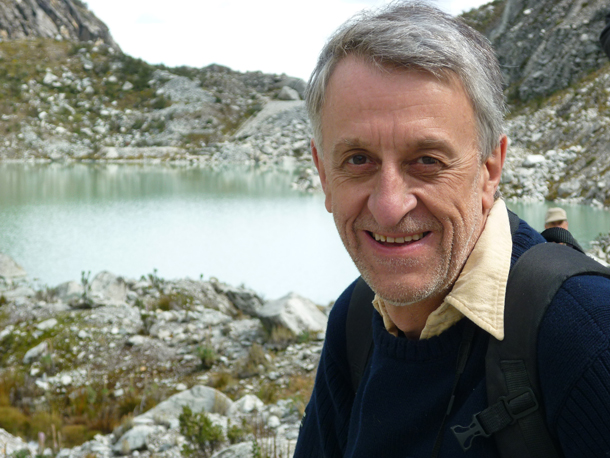
George Black is executive editor of On Earth magazine. (Photo: George Black)
BLACK: Thank you so much, Steve - it's been a pleasure.
Related link:
Read George Black’s Full On Earth Article
[MUSIC: Steely Dan “Your Gold Teeth” from Countdown to Ecstasy (Warner Bros 1973).]
BirdNote ®- Winter Birds Love Suet
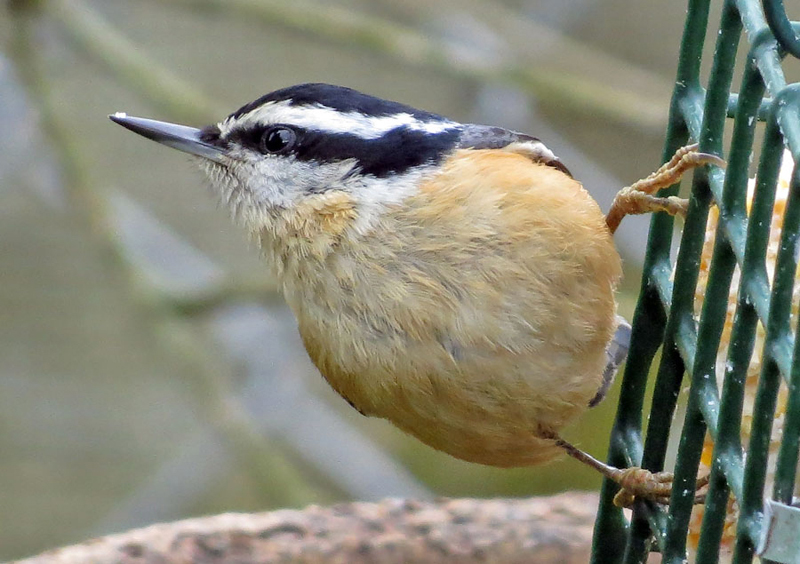
CURWOOD: Now perhaps at this time of year, you're contemplating cutting back on those rich fatty foods after all the holiday festivities. But that's not for the birds! Here's Mary McCann with today's Birdnote®.
MCCANN: At this time of year, birds love fat! With a brilliant flash of its copper-red underwings, a Flicker sails into the yard.
[SOUND: NORTHERN FLICKER’S “KEEYR”]
MCCANN: Just behind it wings a stubby-tailed Red-breasted Nuthatch:
[SOUND: RED-BREASTED NUTHATCH’S “YANK-YANK-YANK”]
MCCANN: Now a couple of energetic Black-capped Chickadees dart in
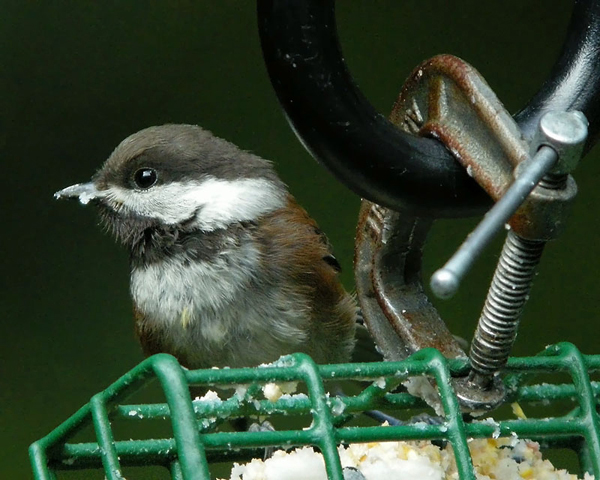
Chestnut-backed Chickadee (Photo: © Mike Hamilton)
[SOUND: SHORT BURST OF “DEE-DEE-DEE” NOTES]
MCCANN: …And a Downy Woodpecker brings up the rear.
[SOUND: DOWNY WOODPECKER CALL]
MCCANN: What’s the attraction? A cake of suet, suspended from a branch in a small wire feeder. Suet is beef fat, a high-energy food critical for birds’ survival in the colder months. With few insects available in winter, suet is an especially strong magnet for birds that eat a lot of bugs in the warmer months. It’s also great for birds with bills that are not adapted to opening seeds.
Bird feeding suppliers now offer a wide array of processed suet cakes, some studded with berries or seeds. Perhaps a bird’s equivalent of a home-baked chocolate chip cookie.
[SOUND: RED-BREASTED NUTHATCH’S “YANK-YANK-YANK”]

Red-breasted Nuthatch (Photo: © Mike Hamilton)
MCCANN: I’m Mary McCann.
CURWOOD: There are pictures of these winter birds feasting on yummy suet-cakes over at our website - LOE dot org.
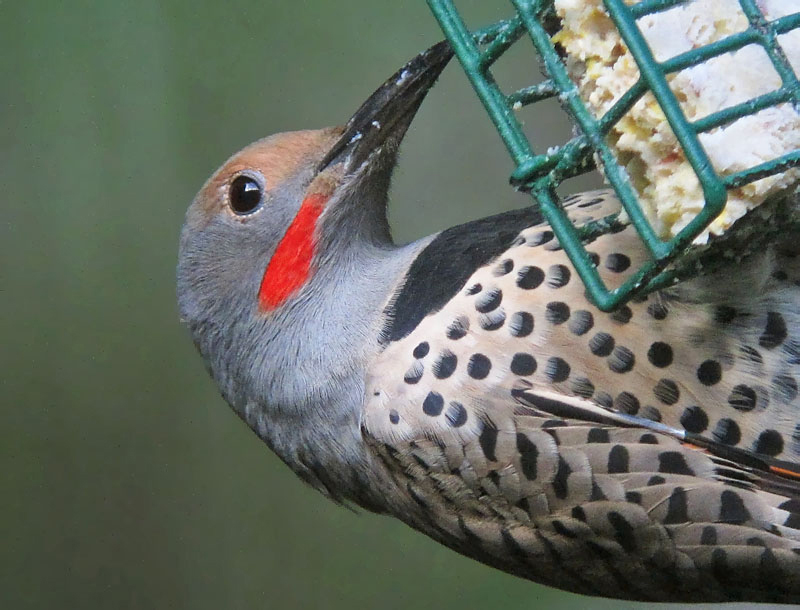
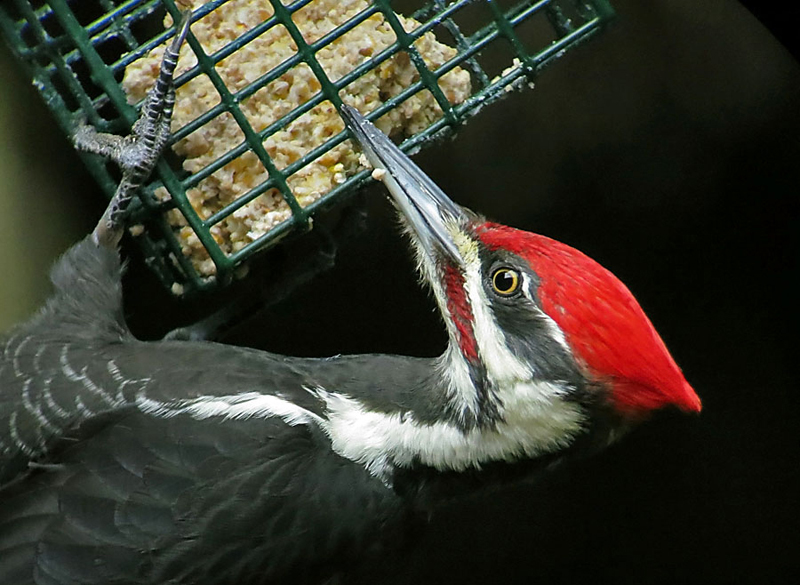

Written by Bob Sundstrom
Bird audio provided by The Macaulay Library at the Cornell Lab of Ornithology, Ithaca, New York. Northern Flicker recorded by W.W.H. Gunn. Red-breasted Nuthatch call recorded by W.L. Hershberger. Black-capped Chickadee call by S.R. Pantle, call of a Steller’s Jay by G.A. Keller, and Downy Woodpecker [62757] call by W.W.H. Gunn.
Producer: John Kessler
Executive Producer: Chris Peterson
© 2012 Tune In to Nature.org November 2012 Narrator: Mary McCann
Related link:
BirdNote®
[MUSIC: Dave Grusin “Serengeti Walk (Slippin’ in the Back Door) “ from GRP 30: The Digital Master Company Anniversary (GRP Records 2012).]
The World Until Yesterday
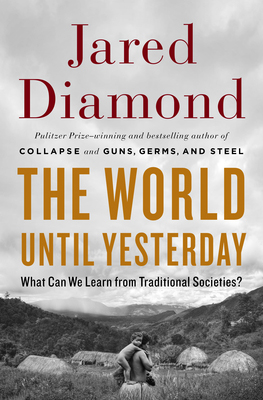
(Penguin Group)
CURWOOD: "Guns, Germs, and Steel" and "Collapse" are two of the mostinfluential social anthropology books ever written. Now author and UCLA professor Jared Diamond is out with a new volume, “The World Until Yesterday.” Professor Diamond intended to write a small book of personal memoirs but says his editors had other plans.
DIAMOND: So, the book evolved into an examination of traditional small societies all around the world throughout history, laced with my anecdotes from New Guinea and learning what lessons these societies have to teach us about how to conduct our own personal lives.
CURWOOD: This new book opens at an airport in Port Moresby, the capital city of Papua New Guinea, where Diamond was struck by the rapid modernization of the island's peoples over the decades that he's done field work there.
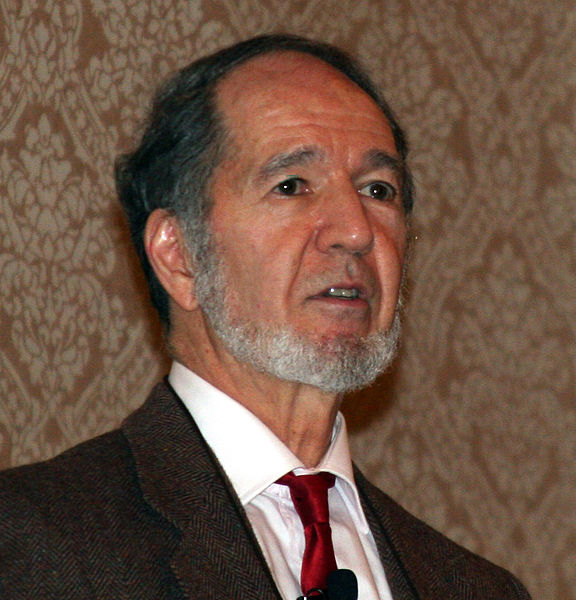
Jared Diamond is a UCLA geography professor and Pulitzer Prize winning author of “Guns Germs, and Steel.“ (Wikimedia Commons)
DIAMOND: It's taken a couple hundred thousand years for anatomically modern humans in many parts of Eurasia to transform themselves from hunter-gatherers without writing to famers and industrial people with writing. But in New Guinea, this has happened in parts of New Guinea within a few decades. And some friends of mine in New Guinea grew up making stone tools and then by the time I met them they were using steel tools and they had writing. The changes have been telescoped in New Guinea into a short time.
CURWOOD: One of your most interesting observations was the different number of people who were in the modern airport and how they would have behaved in the past – can you describe some of that for us?
DIAMOND: Sure. The New Guinea capital city airport that I was in, in 2006, was a normal airport in that when I came in there, there was nobody else in that airport whom I knew – everybody was strangers, the baggage attendants, all the other passengers, and for me, of course, that’s no big deal in our modern society, we’re always encountering strangers. On my drive down here today, everybody that I was passing was a stranger.
But in traditional New Guinea and in any traditional society, people don’t move. If you move, there are rules about who is your friend and who are your enemies. Any stranger is assumed to be an enemy. And so that 2006 New Guinea scene where I was surrounded by strangers would have been unthinkable in traditional New Guinea. I would have freaked out, I would have expected to be killed instantaneously, I would have run or started attacking other people.
CURWOOD: Now, you tell an interesting story, in Papua New Guinea, about this tension among strangers, and how folks diffuse the war that would otherwise begin. And what I’m thinking of is the story of this driver for a company who’s zipping along, a kid darts out from behind a bus and gets run over and killed. The driver, of course, is now expecting that the family of this little boy will now try to kill him. How did this situation get resolved and how does that reflect traditional values and how might we use those values today?
DIAMOND: It’s a gut-wrenching story that was told to me by a friend of mine who was in New Guinea. There was a traffic accident, so, a kid ran out incautiously across the street and got killed. If such a thing happens in the United States, the state intervenes, there may be a criminal case if the driver was incautious, and certainly, there may be a civil case where the relatives of the dead child are going to sue the driver for having killed the child.
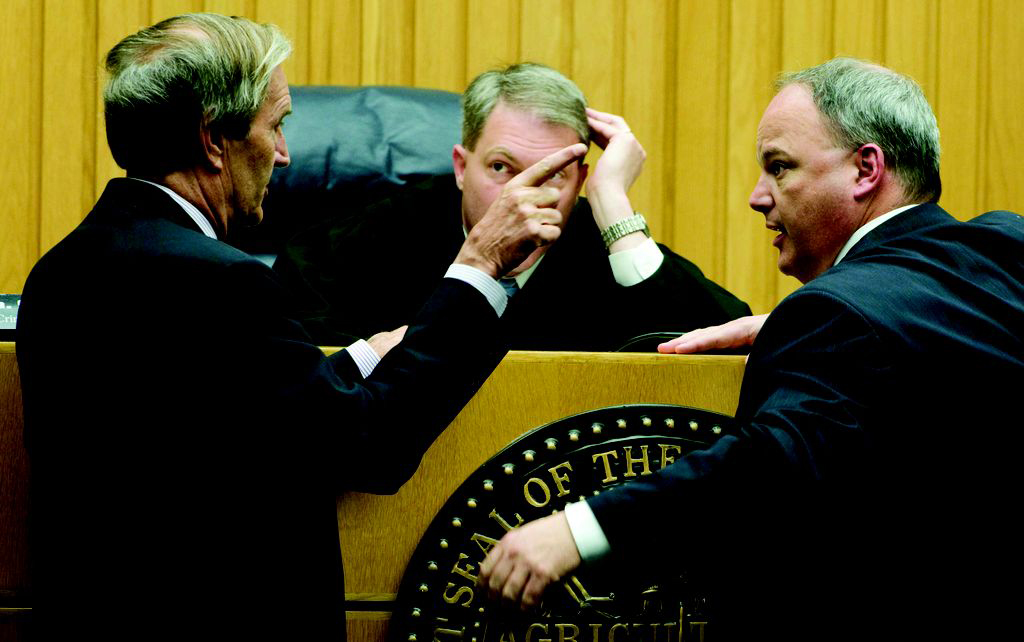
In New Guinea, it’s different. In this case, the next day, the father of the dead boy came to visit the employer of the driver. And the employer was afraid that there was going to be violence but, no, the father of the dead boy wanted to settle the matter in the traditional New Guinea way by payment of compensation. In this case the compensation was large by New Guinea standards, it was several hundred dollars and some food, but trivial by our standards.
And after negotiations, on I think, the fifth day after the accident, the relatives of the dead boy, the father and mother and uncles, sat down together for a meal with the employer of the driver. They made speeches in which they talked about missing the dead boy. My friend made a speech in which he ended up crying because he said, ‘I’m identifying with what you must be going through because I also have young children and nothing can compensate for the death of a young child.’ The end result after five days was that the whole matter was settled, there was emotional clearance, the people went on with their lives, whereas in the United States, the idea that after 5 days you would sit down with the killer of your child is unthinkable. Instead, there would be a lawsuit.

So, this illustrates that in New Guinea, disputes are settled in a way that aims at emotional clearance and getting on with your life. Whereas in a state government, you never meet the person again, the last thing you hear about is emotional clearance and you spend the rest of your life churned up with feelings left over from the accident.
CURWOOD: Now, traditional society in many respects sounds wonderful, and then there are horrible things like killing babies, you mention in your book that sometimes if a baby is born and has a deformity, or sometimes in the case of twins, the mother will kill the newborn for the sake of the tribe as a whole. Can you explain that?
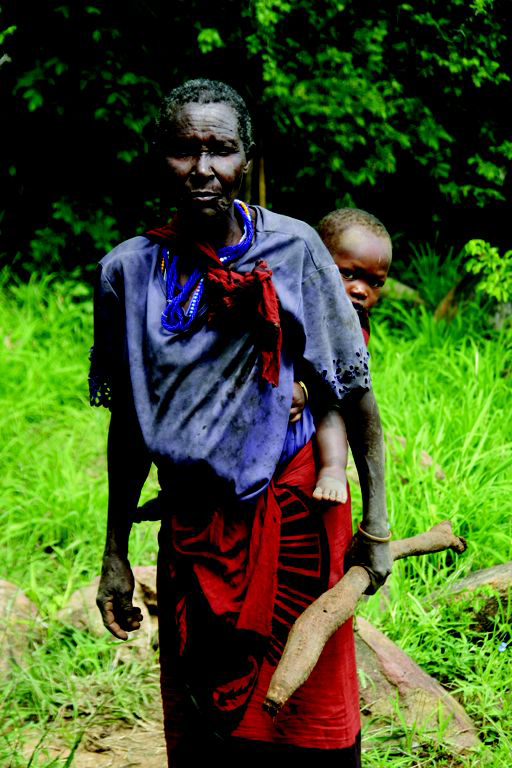
DIAMOND: Yes, it’s true that in many traditional societies, babies who are born impaired are killed. What on earth, though, can you do if you are living in a marginal society? It’s also the case that if you are living in traditional societies, some of them are abandoned or killed…their old people. But what again can you do if you are a small group that is walking to the next camp and you’ve got an old person who is not capable of walking? So, there are both things that we find horrible in traditional societies, and things that we find wonderful in them – often how they bring up their children, often how they treat their old people, how they approach danger, how they remain healthy.
CURWOOD: When you write about the elderly, you title your chapter “Treatment of Old People: Cherish, Abandon, or Kill” and I suppose that sums it all up, but perhaps you could expand on that for us.
DIAMOND: Those are the extremes of choices about what to do with old people. This is an issue that interests me increasingly having passed my 75th birthday some months ago. I used to, when I was a child, thought of 75 as being really old. And now it feels to me as if I’m entering the prime of life. So, in traditional societies, depending on circumstances, old people may be abandoned if there is no way for taking care of them, for example, if the society is nomadic; old people may be encouraged to commit suicide, they may be actively killed.
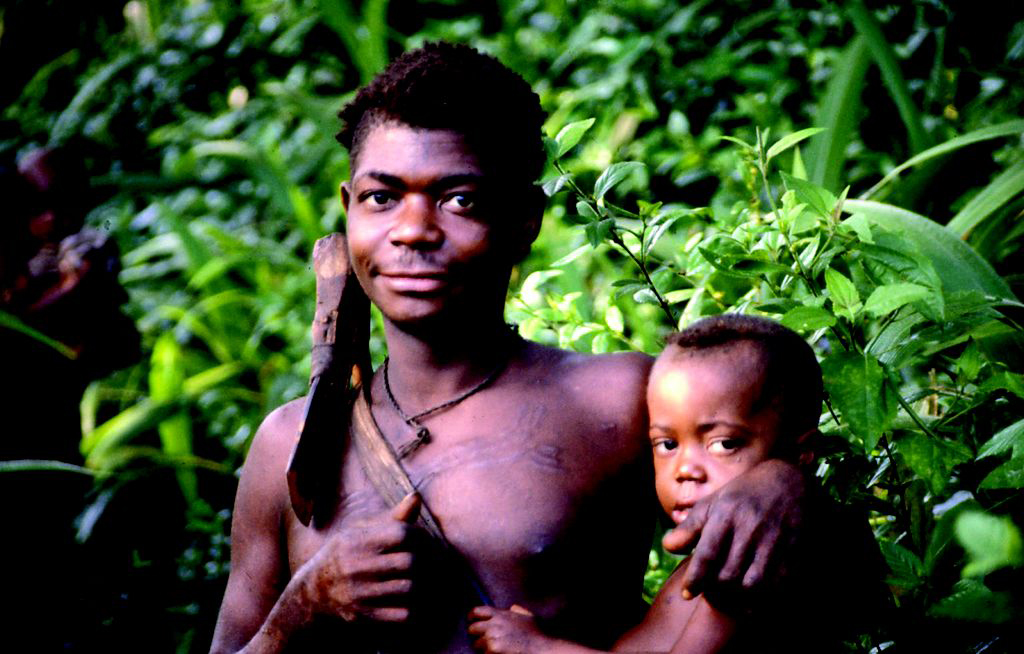
But at the opposite side, old people in societies that are sedentary, that live in permanent huts and villages where it’s easy to take care of old people, then old people will spend their old years surrounded by their children and relatives and friends and they have much more socially rich life, satisfying life, they have much more value than in modern American society.
CURWOOD: I thought the section on raising children was really fascinating. Here in the US most of the games our kids play are teaching them, well, how to compete with their peers. But in your experience from New Guinea, the games that children play in are largely about teaching them how to share. Why do you suppose that is?
DIAMOND: Probably because they are living in small societies where the people with whom you are playing games are the people you’ll be dealing with for the rest of your life. It’s the case that in a really small society, one individual is not supposed to get ahead, instead any individual who is successful is expected to share what he or she gets with other people. But conversely, if you are down on your luck, then you can get food and things from other people.
So, sharing is necessary for survival in traditional societies, in contrast with modern American society. We stress the individual, getting ahead, you do as well as you can and you’re certainly not going to share everything you’ve acquired with all of your relatives and cousins and people you knew 10 years ago.
CURWOOD: As we were preparing for our interview with you, this was happening just as the mass shooting came to light in Newton, Connecticut. I kept wondering how would a tribal community handle a member of the tribe who was emotionally unbalanced in that way.
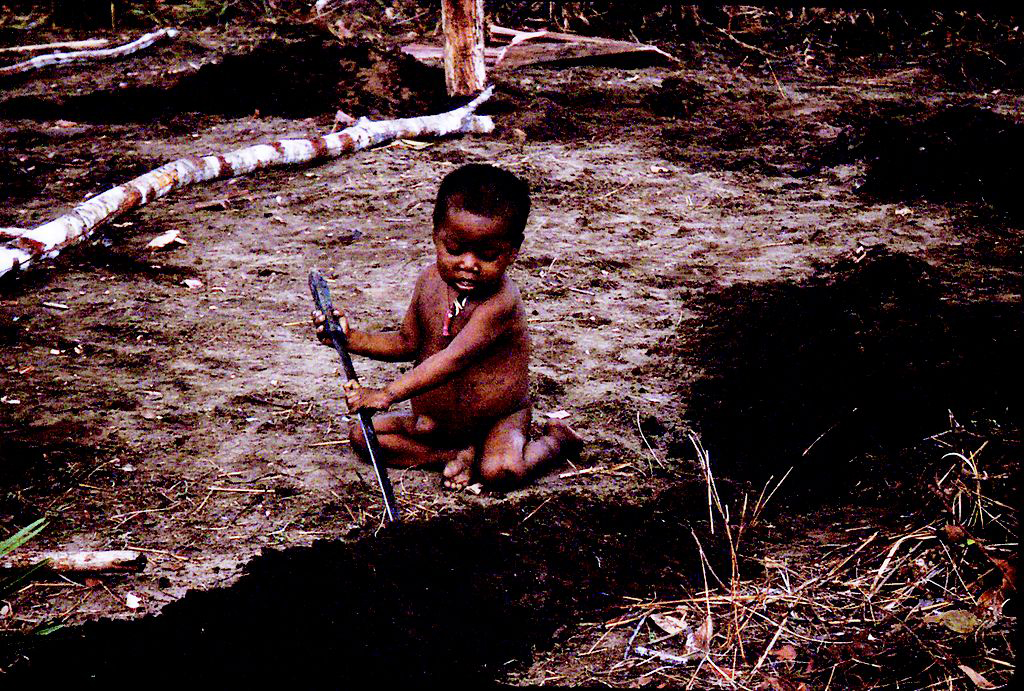
DIAMOND: I’ll give you an example of how a tribal community did deal with a member of the tribe who was emotionally unbalanced. This example came from the Kung San people of the Kalahari Desert of Southwest Africa. The Kung formerly, occasionally, killed each other, and when state control came into place over the Kung, the killing stopped. But there was among the last killings, there, a Kung man who was really, really dangerous and possibly deranged by our standards. He had killed several people.
And finally what happened was that a group of men went into his band, he was there surrounded by members of his band, and in the presence of his relatives, they killed him. The relatives did not interfere because they recognized that this guy was dangerous and deranged, they were too afraid to take care of him themselves, but they did not interfere when other people eliminated him. So, that’s one way to deal with dangerous people in small-scale societies.
CURWOOD: You coined a term in this book that you call constructive paranoia. And you write a couple of chapters about dangers and how to stay safe with this concept - tell me more about this.

DIAMOND: Sure. Dealing with danger is one of the things that I observed in New Guinea and that I have learned that have had the biggest impact on my life and my attitude towards nature. I was camping out with some New Guineans, I was picking campsites in a forest, and I picked what I thought was a gorgeous campsite under a colossal, beautiful tree. And, the New Guineans with me freaked out and they said, ‘we’re not going to sleep under this tree.’ And I said, ‘what’s the matter? Why not?’ And they said, ‘because the tree is dead.’ And I looked up and saw that yes, it is dead, but it was such a big, huge tree that I said ‘it’s not going to fall down for 50 years, don’t be silly.’
But, no, they were not going to sleep under that dead tree. I thought their fears were exaggerated, but then, as I spent more time in New Guinea forest, I realized: OK, well the chance is 1 in 1,000 that this tree is going to crash on me tonight, but if I expect to spend 10,000 nights in the forest because I expect to live 30 years and I spend a lot of time in the forest, if I ignore 1 in 1,000 risks, by the time I’ve run that risk 10,000 times, I’ll have died 10 times over.
How that affects me now is that when I shower in the morning, I recognize that for older people, slipping in the shower is one of the big risks of life, and yes, the chance of my falling down in the shower this morning was only 1 in 1,000, but I intend to take a shower every day for the next 20 or 30 years, and if I’m not careful in the shower then I’m going to end up with a broken hip and then probably be dead. So that’s an example of constructive paranoia guiding my own life. I’m very careful about small things that each time you do them aren’t dangerous but that will eventually catch up with you if you’re not careful.
CURWOOD: Jared Diamond, you are 75 years old now, and you spent most of your adult life traveling back and forth to remote corners of the earth and spending time among traditional tribal peoples. So how did the things you learned inform how you live your life and the way that you raised your own children?
DIAMOND: One is my attitude towards danger that I mentioned. The other is raising children, so I have twin sons who are now 25 years old, and my observations from New Guineans raising their own children informed my raising my children. One thing is that New Guineans and traditional people in general allow their children as much freedom as possible. They consider children to be autonomous creatures capable of making their own decisions and I let my kids make their own decisions insofar as possible.
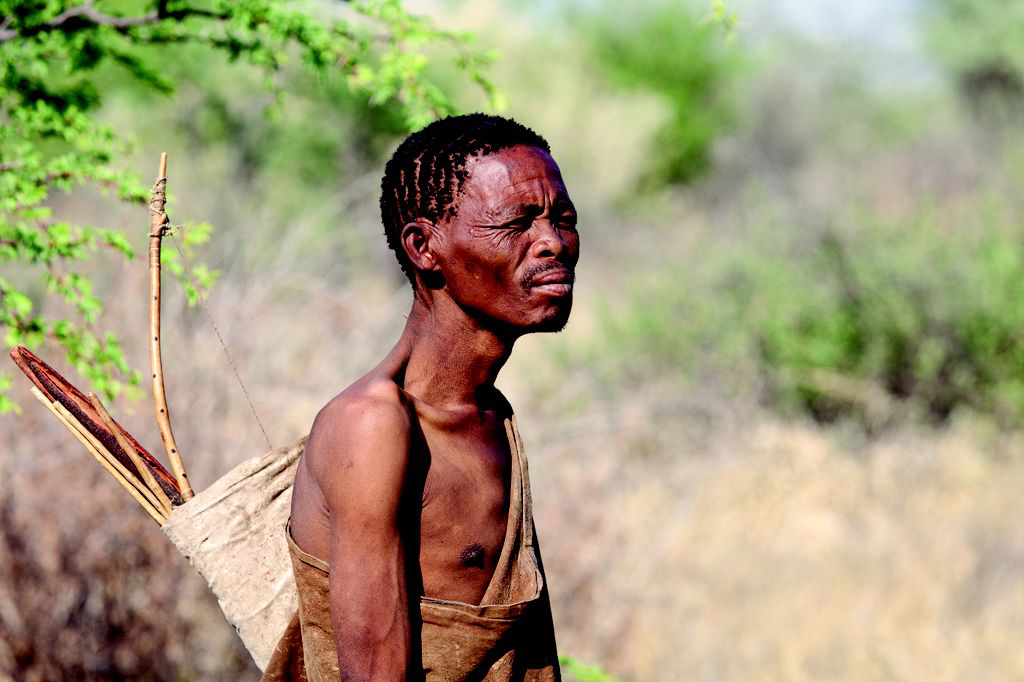
There were some surprising results (laughs). At the age of three my son Max fell in love at first sight with snakes. My wife and I are not snake lovers, but alright, Max loves snakes and let’s help him keep snakes as pets and Max ended up with 147 pet snakes and frogs and lizards. Eventually he got beyond snakes and he got interested in cooking so now he’s a professional chef. But that’s an example of allowing kids the opportunity to choose what they want.
And still another example is that never, not once, did I ever hit my children. I found that it was possible to get them to do what was necessary, to discipline them, without hitting, and, that’s again something that I’ve learned from New Guinea; you never, never hit a child.
CURWOOD: Jared Diamond, what can we expect next from you? Another book, I suppose?
DIAMOND: Yes! I already have an idea for another book which I expect to publish around my 82nd birthday, but I’m still thinking about what might go into that.
CURWOOD: Seven years to write.
DIAMOND: Yes. They take a long time.
CURWOOD: Thank you so much Jared Diamond.
DIAMOND: (Laughs.) You’re welcome.
CURWOOD: Jared Diamond’s new book is called “The World Until Yesterday: What We Can Learn from Traditional Societies.”
Related link:
The World Until Yesterday
[MUSIC: NOT LISTED.]
CURWOOD: Living on Earth is produced by the World Media Foundation. Bobby Bascomb, Emmett Fitzgerald, Helen Palmer, Annie Sneed, James Curwood, Meghan Miner, and Gabriela Romanow all help to make our show. Jeff Turton is our technical director. Alison Lirish Dean composed our themes. You can find us anytime at L-O-E dot org - and check out our Facebook page - it’s PRI’s Living on Earth. I'm Steve Curwood. Thanks for listening!
ANNOUNCER: Funding for Living on Earth comes from Stonyfield Farm, makers of organic yogurt, smoothies, and more. Stonyfield invites you to just eat organic for a day. Details at just eat organic dot com. Support also comes from you, our listeners. The Go Forward Fund. And Pax World Mutual and Exchange Traded Funds. Integrating environmental, social, and governance factors into investment analysis and decision making. On the web at Pax World dot com. Pax World, for tomorrow.
ANNOUNCER 2: PRI Public Radio International.
Living on Earth wants to hear from you!
Living on Earth
62 Calef Highway, Suite 212
Lee, NH 03861
Telephone: 617-287-4121
E-mail: comments@loe.org
Newsletter [Click here]
Donate to Living on Earth!
Living on Earth is an independent media program and relies entirely on contributions from listeners and institutions supporting public service. Please donate now to preserve an independent environmental voice.
NewsletterLiving on Earth offers a weekly delivery of the show's rundown to your mailbox. Sign up for our newsletter today!
 Sailors For The Sea: Be the change you want to sea.
Sailors For The Sea: Be the change you want to sea.
 The Grantham Foundation for the Protection of the Environment: Committed to protecting and improving the health of the global environment.
The Grantham Foundation for the Protection of the Environment: Committed to protecting and improving the health of the global environment.
 Contribute to Living on Earth and receive, as our gift to you, an archival print of one of Mark Seth Lender's extraordinary wildlife photographs. Follow the link to see Mark's current collection of photographs.
Contribute to Living on Earth and receive, as our gift to you, an archival print of one of Mark Seth Lender's extraordinary wildlife photographs. Follow the link to see Mark's current collection of photographs.
 Buy a signed copy of Mark Seth Lender's book Smeagull the Seagull & support Living on Earth
Buy a signed copy of Mark Seth Lender's book Smeagull the Seagull & support Living on Earth

